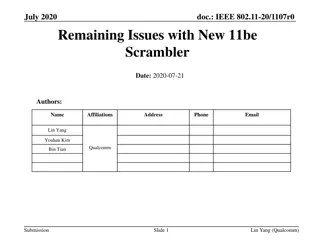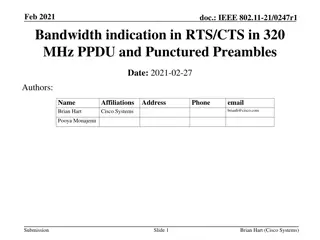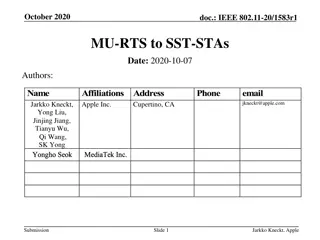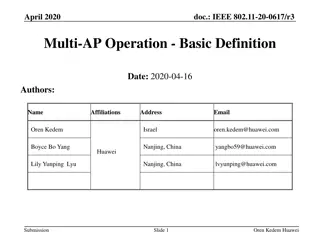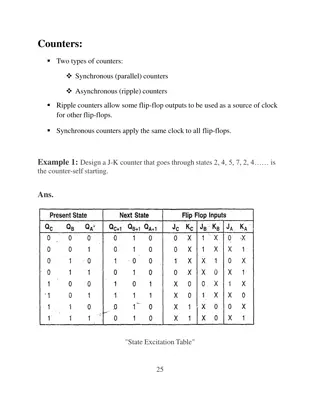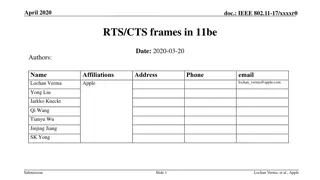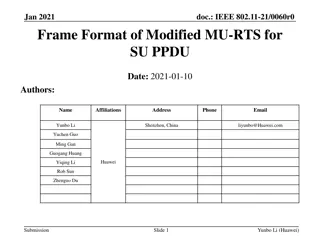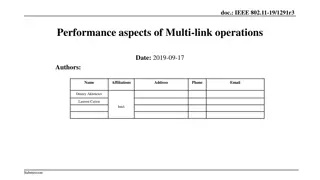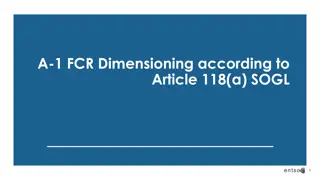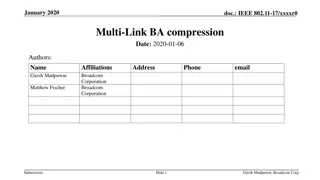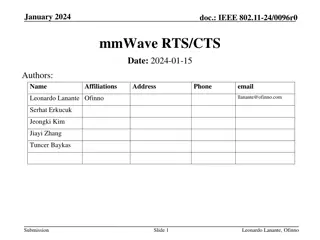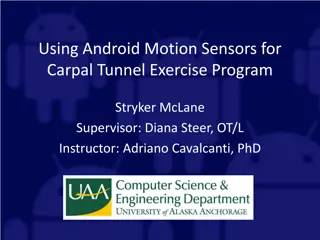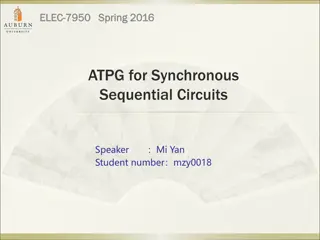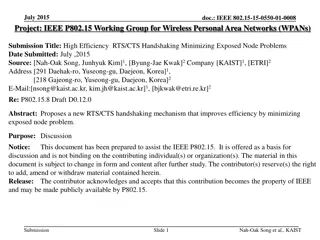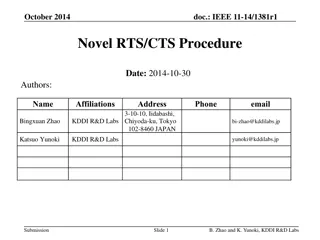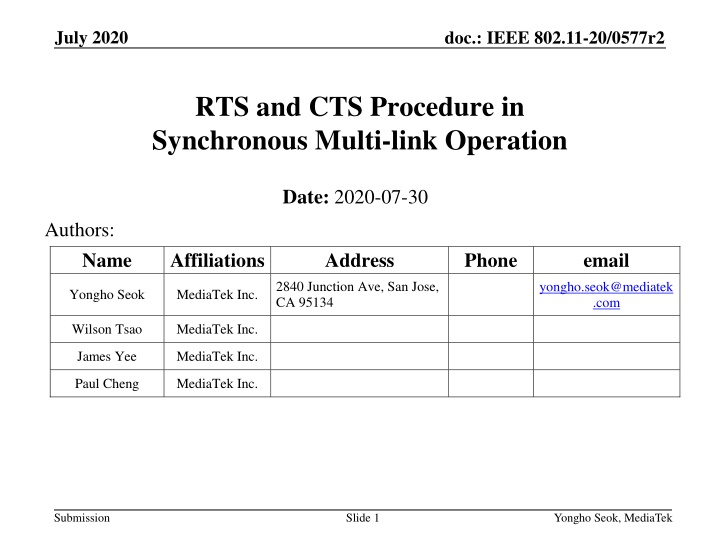
IEEE 802.11-20/0577r2 RTS and CTS Procedure in Synchronous Multi-link Operation
Explore the recap of the Constrained Multi-Link Device (MLD) in synchronous multi-link operation as per IEEE 802.11-20/0577r2. Learn about in-device coexistence interference, synchronization requirements, and the RTS and CTS procedure for DL Synchronous MLO. The solution involving MU-RTS and CTS frames is also discussed to address ending time alignment in PPDU transmissions.
Download Presentation

Please find below an Image/Link to download the presentation.
The content on the website is provided AS IS for your information and personal use only. It may not be sold, licensed, or shared on other websites without obtaining consent from the author. If you encounter any issues during the download, it is possible that the publisher has removed the file from their server.
You are allowed to download the files provided on this website for personal or commercial use, subject to the condition that they are used lawfully. All files are the property of their respective owners.
The content on the website is provided AS IS for your information and personal use only. It may not be sold, licensed, or shared on other websites without obtaining consent from the author.
E N D
Presentation Transcript
July 2020 doc.: IEEE 802.11-20/0577r2 RTS and CTS Procedure in Synchronous Multi-link Operation Date: 2020-07-30 Authors: Name Affiliations Address Phone email 2840 Junction Ave, San Jose, CA 95134 yongho.seok@mediatek .com Yongho Seok MediaTek Inc. Wilson Tsao MediaTek Inc. James Yee MediaTek Inc. Paul Cheng MediaTek Inc. Submission Slide 1 Yongho Seok, MediaTek
July 2020 doc.: IEEE 802.11-20/0577r2 Recap: Constrained Multi-Link Device (MLD) A Constrained MLD is a MLD with which in-device coexistence (IDC) interference occurs when more than one STA within the MLD simultaneously transmits and receives frames on multiple links. When simultaneous Tx and Rx occur on 2.4 GHz band and 5 GHz links, the IDC interference is probably negligible. But, the IDC interference caused by simultaneous Tx and Rx on 5 GHz band and 6 GHz band links may be significantly worse depending on some implementation factors such as RF filter performance. Submission Slide 2 Yongho Seok, MediaTek
July 2020 doc.: IEEE 802.11-20/0577r2 Recap: Constrained Multi-Link Device (MLD) Synchronization requirement [1] A difference between the ending times of PPDU transmissions shall be less than SIFS - (10% aSlotTime). Because a minimum inter-frame space is not less than SIFS, Tx and Rx are not overlapped. A margin of 10% aSlotTime considers the SIFS accuracy of the IEEE 802.11-2016 spec. Difference between the ending times of the transmissions is less than SIFS - (10% aSlotTime). MAC Padding PHY Padding AP Data PE 6GHz SIFS MAC Padding PHY Padding STA Ack PE PHY Padding MAC Padding PE Data AP 5GHz SIFS STA Block Ack Submission Slide 3 Yongho Seok, MediaTek
July 2020 doc.: IEEE 802.11-20/0577r2 RTS and CTS procedure for DL Synchronous MLO When an AP MLD initiates a TXOP on multiple links with the RTS and CTS frames in a non-HT (duplicated) PPDU format, the ending time alignment of the transmissions may not be possible. Because the non-HT (duplicated) PPDU does not support any MAC padding mechanism. RTS AP 6GHz STA No CTS Interference leakage A-MPDU RTS AP 5GHz SIFS STA CTS Submission Slide 4 Yongho Seok, MediaTek
July 2020 doc.: IEEE 802.11-20/0577r2 RTS and CTS procedure for DL Synchronous MLO The solution is to use the MU-RTS and CTS frames, where the MU-RTS frame has the Padding field. The Padding field in the first MU-RTS frame is used to meet the ending times requirement. So, the CTS response of the first MU- RTS frame is delayed until the second RTS/MU-RTS frame on other link is received. RTS/MU-RTS A-MPDU AP 6GHz SIFS STA CTS A-MPDU Padding MU-RTS AP 5GHz SIFS STA CTS Submission Slide 5 Yongho Seok, MediaTek
July 2020 doc.: IEEE 802.11-20/0577r2 RTS and CTS procedure for DL Synchronous MLO Simulation Setup Topology 1 EHT AP and 1 EHT STA. The distance between AP and STA is 10m. Parameters: Each UDP packet is 1460B. Each UDP packet burst is 14.6KB (10 UDP packets). PPDU time is 5.484ms for MCS9 (390Mbps) and 3ms for MCS2 (87.8Mbps). Submission Slide 6 Yongho Seok, MediaTek
July 2020 doc.: IEEE 802.11-20/0577r2 RTS and CTS procedure for DL Synchronous MLO Simulation Setup EHT AP Mode MPC: Multiple Primary Channel (It supports the STR). EHT STA Mode Single Link. AP not aligned: No ending time alignment. AP aligned: The ending times of PPDUs carrying Data frames are aligned. AP/RTS aligned: Besides the ending times of PPDUs carrying Data frames are aligned, the ending times of PPDUs carrying RTS and CTS frames are aligned. Submission Slide 7 Yongho Seok, MediaTek
July 2020 doc.: IEEE 802.11-20/0577r2 RTS and CTS procedure for DL Synchronous MLO Simulation Results Submission Slide 8 Yongho Seok, MediaTek
July 2020 doc.: IEEE 802.11-20/0577r2 Conclusion When the AP MLD simultaneously transmits frames on multiple links to the constrained MLD, the ending time alignment of the DL transmissions always provides the best performance. The MU-RTS frame with has the Padding field can support the ending time alignment for the RTS and CTS procedure. Submission Slide 9 Yongho Seok, MediaTek
July 2020 doc.: IEEE 802.11-20/0577r2 References [1] https://mentor.ieee.org/802.11/dcn/19/11-19-1305-00- 00be-synchronous-multi-link-operation.pptx Submission Slide 10 Yongho Seok, MediaTek
July 2020 doc.: IEEE 802.11-20/0577r2 Straw Poll 1 Do you support that the padding procedure of 11ax (including Padding field in the Trigger frame) can be used when transmitting a Trigger frame to extend the frame length to meet the ending time requirement of the PPDU carrying the Trigger frame in the MLO? Submission Slide 11 Yongho Seok, MediaTek


